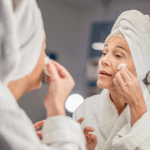Menopause marks a significant transition in the lives of women, typically occurring between the ages of 45 and 55. This natural phase signifies the end of menstrual cycles and is confirmed when a woman has gone without a period for 12 consecutive months. Menopause is accompanied by hormonal changes, primarily a decline in estrogen and progesterone, which can trigger a variety of symptoms ranging from hot flashes and sleep disturbances to mood swings and weight gain. As the body navigates through these changes, lifestyle adjustments become crucial for managing symptoms and maintaining overall health and well-being.
The Importance of Walking for Health During Menopause
Physical activity, particularly walking, emerges as a simple yet effective strategy to address menopausal challenges. Walking is a low-impact exercise that can be easily integrated into daily life, offering a plethora of health benefits without the strain of more intense workouts. Research, including studies from the University of Alberta, has shown that walking can improve mood, enhance sleep quality, and reduce the risk of chronic diseases such as cardiovascular disease and diabetes, which women become more susceptible to during menopause. Furthermore, walking can help in managing weight, strengthening bones, and boosting self-esteem, making it an ideal exercise for midlife women.
Objective of the Article
The objective of this article is to delve into the specific advantages of walking during menopause, with a focus on its impact on brain and skin health. We aim to provide a comprehensive understanding of how regular walking can enhance cognitive function, alleviate mood swings, and support skin vitality. Additionally, we will offer practical tips for incorporating walking into daily routines and address common barriers that may prevent women from engaging in this beneficial activity. By the end of this article, readers will be equipped with knowledge and motivation to embrace walking as a cornerstone of their menopause management plan.
Understanding Menopause and Its Impact
Hormonal Changes and Symptoms
Menopause marks the end of a woman’s reproductive years, characterized by the cessation of menstruation. This transition is primarily driven by hormonal changes, particularly the decline in estrogen and progesterone production by the ovaries. The onset of menopause typically occurs between the ages of 45 and 55, with the average age being around 51. The symptoms associated with these hormonal shifts can vary widely among individuals but often include hot flashes, night sweats, irregular periods, and mood swings. Other symptoms may encompass sleep disturbances, vaginal dryness, and a decrease in libido. The intensity and duration of these symptoms can significantly affect a woman’s quality of life during this period.
Physical and Psychological Effects
The hormonal fluctuations of menopause can lead to a range of physical and psychological effects. Physically, women may experience changes in bone density, leading to an increased risk of osteoporosis and fractures. There can also be alterations in body composition, such as increased abdominal fat and changes in skin elasticity. Psychologically, the menopausal transition can impact mental health, with some women experiencing depression, anxiety, and cognitive changes like memory lapses or difficulty concentrating, often referred to as “brain fog.”
These changes are not only due to hormonal alterations but also to the natural aging process and other lifestyle factors. It’s important to note that while some women navigate through menopause with minimal discomfort, others may find the symptoms more challenging to manage.
The Role of Exercise in Alleviating Symptoms
Exercise, particularly walking, plays a crucial role in managing menopausal symptoms. Regular physical activity has been shown to help alleviate mood swings and anxiety, improve sleep quality, and enhance cognitive function. Walking is a low-impact, accessible form of exercise that can be easily incorporated into daily routines. It helps to maintain cardiovascular health, supports bone density, and can aid in weight management, which is particularly important as metabolism often slows during menopause.
Furthermore, walking can increase the production of endorphins, the body’s natural mood lifters, which may help combat feelings of depression and boost overall well-being. By engaging in regular walking, women can also mitigate the risk of chronic conditions such as heart disease, type 2 diabetes, and certain cancers, which have been associated with postmenopausal life. The simplicity and flexibility of walking make it an ideal exercise for women during menopause, offering a pathway to improved health without the need for specialized equipment or gym memberships.
The Benefits of Walking for Brain Health During Menopause
Enhancing Cognitive Function
Regular walking during menopause can have a significant impact on cognitive function. Studies have shown that physical activity, including walking, stimulates the production of brain-derived neurotrophic factor (BDNF), a protein that supports the survival of existing neurons and encourages the growth of new neurons and synapses. This is particularly important during menopause, a period when women may experience cognitive changes such as memory lapses and difficulty concentrating. By incorporating walking into their daily routine, menopausal women can help maintain and even improve cognitive functions like memory, attention, and processing speed.
Reducing the Risk of Cognitive Decline
As we age, the risk of cognitive decline increases. Menopause, with its hormonal changes, can exacerbate this risk. However, walking can serve as a protective factor. Aerobic exercise, such as brisk walking, has been associated with a lower risk of developing cognitive impairments, including dementia and Alzheimer’s disease. The increased blood flow to the brain during exercise is thought to promote the health of brain cells and the survival of new ones, potentially reducing the risk of cognitive decline associated with menopause.
Alleviating Mood Swings and Anxiety
Menopause can often be accompanied by mood swings and increased anxiety. Walking, especially in nature, can be a powerful mood stabilizer. The rhythmic, repetitive motion of walking has a calming effect on the brain, reducing stress hormones and stimulating the release of endorphins, which are natural mood lifters. Regular walking can help menopausal women manage their mood swings and reduce feelings of anxiety, contributing to overall mental well-being.
Supporting Sleep Quality
Many women experience sleep disturbances during menopause. Walking can improve sleep quality by helping to regulate the body’s natural sleep-wake cycle, known as the circadian rhythm. Exercise such as walking increases the amount of time spent in deep sleep, the most physically restorative sleep phase. Improved sleep can, in turn, support cognitive health, as the brain uses this time to consolidate memories and repair itself.
Boosting Brain-Protective Factors
Walking increases the flow of blood to the brain, which delivers oxygen and nutrients vital for brain health. This increased blood flow also helps to flush out waste products from brain metabolism. Additionally, walking can stimulate the release of various growth factors that protect brain health, such as vascular endothelial growth factor (VEGF) and insulin-like growth factor (IGF-1). These factors not only support the health of existing brain cells but also promote the growth of new blood vessels in the brain, enhancing its ability to adapt and respond to changes, a process known as neuroplasticity.
In conclusion, walking is a simple, accessible form of exercise that offers numerous benefits for brain health during menopause. By enhancing cognitive function, reducing the risk of cognitive decline, alleviating mood swings and anxiety, supporting sleep quality, and boosting brain-protective factors, walking can help women navigate the challenges of menopause while maintaining their mental acuity and emotional balance.
Walking and Skin Health in Menopause
Improving Blood Circulation
One of the lesser-known yet significant benefits of walking during menopause is the enhancement of blood circulation. As women engage in regular walking, the heart pumps blood more efficiently, delivering oxygen and nutrients to skin cells. This improved circulation can lead to a healthier, more vibrant complexion. The increased blood flow also helps in the removal of waste products from skin cells, which can prevent dullness and promote a natural glow.
Stimulating Collagen Production
Collagen, the protein responsible for skin elasticity and firmness, tends to decrease as estrogen levels drop during menopause. Walking can counteract this effect by stimulating collagen production. The physical activity boosts the synthesis of growth factors that contribute to skin repair and collagen formation. This means that incorporating a brisk walk into your daily routine could help maintain the skin’s resilience and reduce the appearance of fine lines and wrinkles.
Reducing Stress and Signs of Aging
Menopause can be a stressful time, and stress is a well-known accelerator of the aging process. Walking is a natural stress reliever; it encourages the release of endorphins, which are hormones that promote feelings of well-being. By reducing stress levels, walking not only helps in managing menopausal symptoms but also slows down the signs of aging on the skin. Less stress means less cortisol, which in turn means less collagen breakdown and a more youthful appearance.
Enhancing Lymphatic Drainage
The lymphatic system plays a crucial role in detoxifying the body, and its proper functioning is essential for maintaining skin health. Walking aids in lymphatic drainage, helping to remove toxins and reduce puffiness by encouraging the movement of lymph fluids throughout the body. This can result in clearer skin and may also help to minimize the occurrence of acne breakouts, which some women experience during menopause.
Maintaining Overall Health and Wellness
Lastly, walking contributes to overall health and wellness, which is intrinsically linked to skin health. By improving cardiovascular health, bone density, and muscle strength, walking helps to create a strong foundation for the body’s systems to function optimally. A healthy body supports healthy skin, making walking an all-encompassing activity for menopausal women who are looking to preserve their skin’s vitality and combat the signs of aging.
In conclusion, walking is a simple yet powerful tool for supporting skin health during menopause. It promotes blood circulation, collagen production, stress reduction, lymphatic drainage, and overall wellness, all of which contribute to a healthier, more youthful complexion. As part of a holistic approach to menopause management, walking can be a cornerstone of a healthy lifestyle that benefits both the brain and the skin.

Practical Tips for Incorporating Walking into Daily Life
Choosing the Right Footwear
When embarking on a walking regimen, the importance of proper footwear cannot be overstated. Shoes that provide good arch support and cushioning can prevent foot pain and injuries, making your walks more enjoyable and sustainable. Look for sturdy, comfortable shoes or walking boots, and consider visiting a specialty store where you can receive expert advice on the best fit for your feet.
Setting Realistic Walking Goals
Setting achievable goals is crucial for maintaining motivation and measuring progress. Start with modest targets, such as a 10-minute walk each day, and gradually increase the duration and intensity. Utilize tools like the balance app to track your steps and celebrate milestones. Remember, even short walks can contribute to your overall health and well-being.
Creating a Consistent Walking Routine
Consistency is key to reaping the benefits of walking. Aim to integrate walking into your daily schedule at times that work best for you. Whether it’s a morning stroll to kickstart your day or an evening walk to decompress, find a routine that you can stick to. To keep things interesting, vary your routes and consider walking with a friend or listening to music or podcasts.
Overcoming Common Barriers to Walking
Common obstacles such as lack of motivation and time constraints can hinder your walking routine. To combat these challenges, plan your walks as you would any important appointment, and remember the positive effects walking has on your mood and energy levels. If menopausal symptoms are a barrier, know that walking can actually help alleviate them. For those concerned about safety, choose well-lit, populated routes and wear reflective clothing if necessary. Lastly, if you’re struggling with motivation, join a walking group or enlist a walking buddy for accountability and social interaction.
Additional Considerations for Walking During Menopause
Addressing Foot Health and Comfort
When incorporating walking into your menopause management routine, foot health and comfort are paramount. The right footwear can make a significant difference in your walking experience. Choose shoes with adequate arch support, a comfortable fit, and good cushioning to absorb impact. This is especially important as menopause can sometimes lead to decreased bone density, making you more susceptible to stress fractures. Additionally, consider the use of custom orthotics if you have specific foot conditions. Remember to replace your walking shoes regularly to ensure ongoing support and cushioning.
Weather and Terrain Adaptations
Menopause can make you more sensitive to temperature changes, so it’s important to adapt your walking routine to different weather conditions. In hot weather, walk during cooler times of the day, wear breathable clothing, and stay hydrated. In colder climates, layer your clothing to maintain body heat and choose footwear with good traction to prevent slips on icy surfaces. When it comes to terrain, start with flat, even surfaces and gradually introduce varied terrain, such as hills or trails, to challenge your body and keep your walks interesting.
Monitoring Progress and Adjusting Goals
Tracking your walking progress is motivating and can help you stay committed to your routine. Use a simple pedometer, a smartphone app, or a wearable fitness tracker to monitor steps, distance, and even your heart rate. Set realistic and achievable goals, such as a certain number of steps per day or specific distance goals for the week. As you build stamina and strength, adjust your goals accordingly. Celebrate your achievements, no matter how small, and if you encounter setbacks, be kind to yourself and adjust your goals to better suit your current abilities and circumstances.
By considering these additional factors, you can enhance your walking experience during menopause, ensuring it remains a beneficial and enjoyable part of your daily routine.

THEN IT CONTAINS TOXIC CHEMICALS. WHY RISK IT GETTING SICK? GO CHEMICAL FREE.
Conclusion
Throughout this article, we have explored the multifaceted benefits of walking, particularly during menopause, for both brain and skin health. Walking, a simple and accessible form of exercise, has been shown to enhance cognitive function, reduce the risk of cognitive decline, and alleviate mood swings and anxiety. It supports sleep quality and boosts brain-protective factors, which are crucial during the hormonal changes of menopause. For skin health, walking improves blood circulation, stimulates collagen production, and reduces stress-related signs of aging. It also enhances lymphatic drainage, contributing to the maintenance of overall health and wellness.
Encouragement for Continued Research and Practice
While the evidence supporting the benefits of walking is compelling, continued research is essential to further understand the underlying mechanisms and optimize walking protocols for menopausal women. Healthcare professionals should encourage the practice of walking as part of a holistic approach to managing menopause symptoms. Additionally, further studies could explore the synergistic effects of walking combined with other lifestyle modifications, such as diet and stress management, on menopausal health outcomes.
Final Thoughts on Embracing Walking During Menopause
Embracing walking during menopause is a proactive step towards enhancing brain and skin health. It is a low-impact, cost-effective, and versatile activity that fits easily into daily life. By setting realistic goals, choosing the right footwear, and creating a consistent routine, menopausal women can harness the power of walking to navigate this transitional phase with greater ease and vitality. Ultimately, walking is more than just a form of physical exercise; it is a pathway to improved quality of life and well-being during menopause and beyond.




















